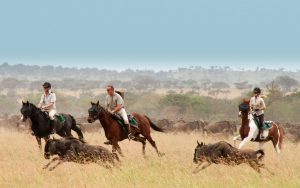Are you looking for luxury Zimbabwe safari holidays? Well, you have come to the right place! Here at Ubon Safari, we provide luxury Zimbabwe holidays and exquisite African safari tours. Zimbabwe is a beautiful country which offer lots of wilderness animals, outstanding cuisine, attractions, national parks, games reserves and so much more! Our safari luxury holidays in Zimbabwe has never been more exciting.
Zimbabwe is a landlocked country in the southern part of Africa with South Africa bordering its south, Zambia to its north, Botswana to its west and Mozambique to its east. With Bulawayo and Harare being the two main cities, the Zimbabwe divides into 8 provinces. The country was formerly known as Southern Rhodesia. In 1961, the country got its name Zimbabwe.
It remains one of the most intriguing destinations in the world. Our Zimbabwe safari holidays offer a large variety of scenery, make it one of the African continent’s finest and largest concentrations of wildlife and perfect climate with an average of 7 hours sunshine daily throughout the year. Also, Zimbabwe is home to one of the 7 natural wonders of the world, the magnificent Victoria Falls, this avalanche of water beckons invitingly in the heat of the African sun.
CAPITAL CITY: HARARE
AIRPORT: HARARE INTERNATIONAL AIRPORT
CURRENCY: US DOLLAR (US$)
LANGUAGE: ENGLISH, SHONA AND SINDEBELE
VOLTAGE: 220V/50Hz UK Plug
DRY SEASON:
APRIL TO OCT – GREAT FOR WILDLIFE SPOTTING
JUNE TO SEPT – GREAT FOR VICTORIA FALLS
WET SEASON:
NOV TO MARCH – GREEN SCENERY, CALVING SEASON, GREAT BIRDWATCHING, THICK VEGETATION
ROADS CAN BE IMPASSABLE
BEST TIMES:
MAY TO SEPTEMBER
HIGH SEASON – JULY – OCTOBER (VICTORIA FALLS IS BUSY)
LOW SEASON – NOVEMBER – APRIL (SOME LODGES ARE CLOSED)
BEST WEATHER:
APRIL, MAY, SEPTEMBER
Go to our Visa page to find out whether you need a visa to enter Zimbabwe
http://thetravelvisacompany.co.uk/ubonsafari/zimbabwe/
Find out more about Zimbabwe on the largest travel guidebook online
https://www.lonelyplanet.com/zimbabwe
FREQUENTLY ASKED QUESTIONS
DO I NEED A VISA
AUSTRALIA – YES / EUROPEAN COUNTRIES – YES / UNITED KINGDOM – YES / USA – YES
Please enquire with the Zimbabwean Embassy in your country of Residence as we recommend you get you visa before you before you travel.
There is an option for a KAZA UNIVISA which allows you to cross between Zambia and Zimbabwe only, multiple times and is valid for 30 days.
You can purchase this Visa in arrival (only at the border points between these countries) and has to be paid in cash. For more information www.kazavisa.info
TIPPING
It is not mandatory to tip however we do recommend you to tip in Restaurants, Bars something that would suit you. For Drivers, Guides and Porters we recommend a minimum of USD 5 per person per day.
INTERNET ACCESS
Most places have WIFI / internet, however in camps and lodges you may be limited to some specified areas, in camping safaris thereis no internet.
MOBILE PHONE ACCESS
Most of the locations in Zimbabwe have great mobile coverage especially in cities and towns. There’s limited access in some of the rural areas. A local sim would be easily available for purchase.
WHAT ARE THE TOILETS LIKE?
Western style Toilets are available in most hotels, lodges and camps. Some areas may have squat toilets.
DRINKING WATER
Drinking tap water is not recommended. Mineral water is always available.
ARE CREDIT CARDS ACCEPTED?
Please inform your Bank before you travel to ensure you will not have problems using your cards. Credit card facilities are available in some areas only.
Carry small denominations of US Dollars and South African Rand as Zimbabwean Dollar is no longer acceptable.
ATMS:
ATMs are available in major cities and towns.
DO I NEED A TRAVEL INSURANCE?
It is mandatory you should have Health / Travel Insurance
PUBLIC HOLIDAYS
Please see http://www.worldtravelguide.net/zimbabwe/public-holidays
ELECTRICITY / PLUGS:
Electricity in Zimbabwe has 220V and 3 Pin flat plugs although some new hotels are now having round pin plugs so carry your travel plug.
DOES ZIMBABWE HAVE MALARIA:
Yes, visit your GP before you travel for your vaccinations and Malaria pills.
TRAVEL TIPS
- Dress respectfully, shoulders to knees should be covered especially in when entering places of worship.
- Respect local traditions, customs and religions
- Please do not buy coral, ivory or any animal products
- Dispose of litter appropriately in bins
- Do not throw cigarette butts especially in the parks as it may cause fire and destroy wildlife and habitats.
- Don’t be afraid to learn the local language and smile.
- Please support the local shops and people
- When taking photos of people please ask permission
At Ubon Safari, we decide our time and efforts to provide our customers and clients with outstanding safari tours and luxury African beach holidays. If you would like to book a trip of a lifetime for our luxury Zimbabwe safari holidays, email info@ubonsafari.com and we will respond to your enquiry as soon as possible.



